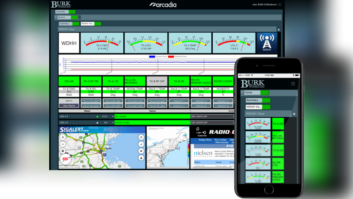Here’s an item of interest from Doug Lung, editor of the RF Report, published by our sister publication TV Technology:
The pictures from Mars rovers Spirit and Opportunity have focused interest in the planet. Based on Web information, (http://ipnpr.jpl.nasa.gov/tmo/progress_report/42-153/153H.pdf) the rovers are using frequencies around 430 MHz to communicate with the orbiting spacecraft at data rates up from 128 kbps to 2 Mbps. The link from Mars to Earth uses X-band frequencies in the 8.4 to 8.45 GHz band, while the return link from Earth to Mars uses frequencies around 7.2 GHz.
See the link above for a description of the design of future communications systems between Mars and the orbiter and the orbiter and Earth and a limited description of existing links. Also see www-mgcm.arc.nasa.gov/mgcm/micromet/mars_relay_comm.html for a detailed explanation of Mars-Orbiter and Mars-Earth communications system.
If you watched the landing of Opportunity on Mars you heard many references to “tones” that the lander used to send status information back to Earth. These tones are generated by a radio called the Small Deep Space Transponder using a special form of 256-tone MFSK modulation. Note that frequency shift keying rather than phase modulation is used to allow better frequency tracking during periods of high dynamics present during the entry, descent and landing (EDL) process. The radio operates at 8.4 GHz and communicates with Earth using the back shell low-gain antenna, switching to the rover low-gain antenna when the lander separates from the back shell. Even with the 70 meter Deep Space Network antenna (http://deepspace.jpl.nasa.gov/dsn/), the signal to noise ratio can drop as low as 22 dB-Hz and the demodulator has to deal with a Doppler rate up to 1200 Hz/second.
As you can imagine, this required an extremely robust modulation system. The following paper that describes the design and performance of the system called Direct-to-Earth Communications and Signal Processing for Mars Exploration Rover Entry, Desceng and Landing at http://ipnpr.jpl.nasa.gov/tmo/progress_report/42-153/153A.pdf
The paper describes the operation of the system this way: “There will be 256 different signal frequencies, modulated one at a time onto a subcarrier, using the spacecraft capability to switch the subcarrier frequency. During hypersonic entry, the signal frequency can be switched every 10 s, resulting in the communication of 8 bits of information each 10 s. When the lander is suspended from the bridle, and the UHF link is prime, the duration of the modulation frequencies may be extended to 20 s to better facilitate detection during this period of highly varying SNR. This would result in fewer messages of higher reliability than would the use of the 10-s duration.” The paper includes a detailed mathematical analysis of the system. NASA’s Spotlight series has a simpler explanation of the tones. See www.jpl.nasa.gov/news/features/tones.cfm.
With all the spacecraft converging on Mars this year, you may be wondering how frequencies were coordinated to keep them from interfering with each other. That coordination is the responsibility of the Space Frequency Coordination Group (http://sfcgonline.org/). While some of the documents on the Web site require a password for access, Frequency Assignment Guidelines for Communications in the Mars Region (http://sfcgonline.org/handbook/rec/rec22-1r1.pdf) as well as the STCG Handbook 2002 (http://sfcgonline.org/handbook/SFCG_Handbook_2002.pdf) and other Resolutions and Recommendations (http://sfcgonline.org/handbook/res/index.shtml) do not.
Recommendation 22-1R1 includes a summary of the frequency bands available for communications on and with Mars and outlines how frequencies are to be selected and coordinated.
Frequency Coordination… on Mars!
Frequency Coordination... on Mars!












